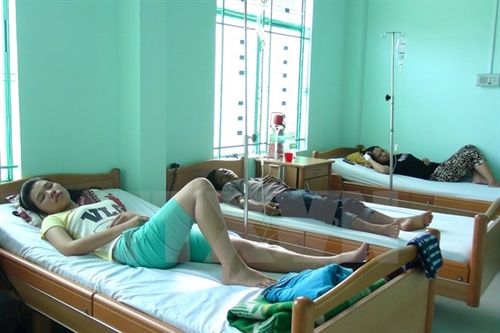 Society
Society

The number of dengue fever cases has soared in the southern province of Ninh Thuận and HCM City, although the disease often peaks in the rainy season.
 |
| A patient with dengue fever rests in hospital. The number of dengue cases has soared in the southern province of Ninh Thuận and HCM City, though the disease usually peaks in the rainy season. VNA/VNS Photo Nguyên Lý |
NINH THUẬN – The number of dengue fever cases has soared in the southern province of Ninh Thuận and HCM City, although the disease often peaks in the rainy season.
Nguyễn Nhị Linh, director of Ninh Thuận Province’s Preventive Health Centre, said it was not yet an epidemic, but 287 dengue fever cases had been recorded since the beginning of this year, compared with just 10 cases reported in the same period last year.
Phan Rang-Tháp Chàm City had the highest number with over 100 cases, followed by Ninh Phưóc, Ninh Sơn and Ninh Hải districts.
Health officials blamed the rise in infections on relaxed prevention efforts.
Inspections conducted at some localities in the province have found that up to 46 per cent of households have water containers with plenty of mosquito larvae. This is a convenient environment for mosquitoes to proliferate and infect humans.
Normally, dengue fever outbreaks occur in Ninh Thuận Province during the rainy season, from June to November, as the weather is favourable for mosquitoes to thrive in containers with stagnant water, swampy areas and buckets containing rainwater around homes.
Vaccines and treatment for the dengue virus are not yet available, so Ninh Thuận Province’s Preventive Health Centre has worked with local authorities to raise residents’ awareness of dengue fever prevention.
Meanwhile, in HCM City, the number of dengue fever cases was also reportedly on the rise.
Doctor Nguyễn Hữu Hưng, deputy director of the HCM City Health Department, said 6,116 cases required hospitalisation at the end of April, an increase of 88 per cent compared with the same period last year. One fatality has been reported so far in Hóc Môn District.
Most dengue fever hotspots in the city have been controlled, he said.
The number of infections in March reached 250 cases a week, on average.
Hưng blamed the rise of hospitalisations on the fact that dengue fever reached its peak late last year.
The city plans to continue its media campaign to eliminate mosquitoes and larvae.
For efficient monitoring of disease prevention and control in the city, the municipal Preventive Health Centre has co-ordinated with the Department of Science and Technology to implement a global positioning system to chart infectious disease outbreaks on a map. This helps to quickly locate the outbreak and plan timely measures to curb the epidemic. The project has been piloted at health stations in six wards.
Dengue fever infects between 50,000 and 100,000 people in Việt Nam every year, killing nearly 100 annually, according to the Ministry of Health.
Last year, about 82,000 cases of dengue fever were recorded in the country, including 52 fatalities.
Health experts have warned that dengue fever would continue to rise.
Urbanisation, which is occurring at an alarming rate, coupled with poor sanitation and an increase in the quantities of waste and stagnant water, is one factor that contributes to the problem.
In addition, as a result of the El Nino phenomenon, severe drought in many areas has led people to store water at their homes, which creates a favourable environment for mosquitoes to breed. - VN




